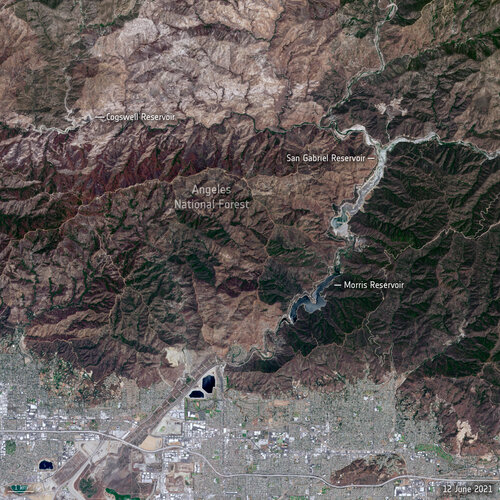21.6.2021 14:05
ČÚZK - předpisy a opatření
Katastrální úřad pro Královéhradecký kraj kancelář ředitele
vypisuje výběrové řízení na místo
účetní Katastrálního úřadu pro Královéhradecký kraj
21.6.2021 14:05
ČÚZK - volná místa
Katastrální úřad pro Královéhradecký kraj kancelář ředitele vypisuje výběrové řízení na místo účetní Katastrálního úřadu pro Královéhradecký kraj
21.6.2021 14:05
ČÚZK
/Urady/Katastralni-urady/Katastralni-urady/Katastralni-urad-pro-Kralovehradecky-kraj/Volna-mista/DMS/ucetni-Katastralniho-uradu-pro-Kralovehradecky-kra
21.6.2021 9:20
Unicorn
Před třemi lety jsme se v Unicornu spojili s Českou zemědělskou univerzitou v Praze a společně vytvořili aplikaci ForestGuard, která dokáže odhalit škůdce všech smrků - kůrovce. Jak je to možné? Co je podstatou detekce? Může aplikace zachránit české lesy? Poslechněte si naše odborníky na GIS systémy, kteří vám povědí více.
21.6.2021 9:20
ESA Observing the Earth

ESA is inviting up to 25 committed mobile app developers and specialists in artificial and machine learning related to observing Earth from space to join this year’s Space App Camp, which will be a virtual event over eight weeks, from 20 July to 20 September.
21.6.2021 9:16
ČÚZK
/Urady/Zememericke-a-katastralni-inspektoraty/Zememericke-a-katastralni-inspektoraty/Zememericky-a-katastralni-inspektorat-v-Opave/Uredni-deska/Oznameni-a-jina-uredni-sdeleni/Volna-mista/DMS/odborny-rada-inspektor-Zememerickeho-a-katastral
21.6.2021 9:16
ČÚZK - volná místa
Zeměměřický a katastrální inspektorát v Opavě vypisuje výběrové řízení na místo odborný rada - inspektor Zeměměřického a katastrálního inspektorátu v Opavě
21.6.2021 9:16
ČÚZK - předpisy a opatření
Zeměměřický a katastrální inspektorát v Opavě
vypisuje výběrové řízení na místo odborný rada - inspektor
odborný rada - inspektor Zeměměřického a katastrálního inspektorátu v Opavě
19.6.2021 3:00
GISCafe.com Webcasts-Webinars
June 21, 2021 -- Leading subsea laser and imaging provider 2G Robotics has rebranded to Voyis and confirmed a new leadership team.
Over the last 10+ …
19.6.2021 3:00
GISCafe.com Webcasts-Webinars
Leading subsea laser and imaging provider 2G Robotics has rebranded to Voyis and confirmed a new leadership team.
Over the last 10+ years, 2G …
19.6.2021 2:55
GISCafe.com Webcasts-Webinars
Purpose-built for Distribution Engineers and Designers, the latest release adds revolutionary functionality for faster work and clearer insight for …
19.6.2021 2:53
GISCafe.com Webcasts-Webinars
Westminster, Colo., June 8, 2021—Spectra Geospatial introduced today the Spectra® Geospatial Origin software and the new Ranger 5 …
19.6.2021 2:39
GISCafe.com Webcasts-Webinars
Paris, France (June 15, 2021) – Aplines, an asset management software company for the electric utilities industry, announced today that it will …
18.6.2021 16:45
BIM News
Národní centrum Průmyslu 4.0 založilo novou platformu „Stavebnictví 4.0“. Dohoda o spolupráci mezi výzkumnými pracovišti a stavebními firmami byla podepsána 17. června 2021 na Ministerstvu průmyslu a obchodu. Ambicí je spojit významná výzkumná pracoviště, zejména na technických univerzitách, se stavebními firmami a nabídnout prostor pro spolupráci. Bude se tak dít nejen v prostorách Českého institutu […]
The post Vznikla platforma Stavebnictví 4.0 pro spolupráci mezi firmami a výzkumnými pracovišti appeared first on BIM News.
18.6.2021 11:50
ČÚZK - volná místa
Katastrální úřad pro Jihomoravský kraj Katastrální pracoviště Znojmo vypisuje výběrové řízení na místo Rada/odborný rada v oddělení aktualizace KN č.2 na Katastrálním pracovišti Znojmo
18.6.2021 11:50
ČÚZK - předpisy a opatření
Katastrální úřad pro Jihomoravský kraj Katastrální pracoviště Znojmo
vypisuje výběrové řízení na místo
Rada/odborný rada v oddělení aktualizace KN č.2 na Katastrálním pracovišti Znojmo
18.6.2021 11:50
ČÚZK
/Urady/Katastralni-urady/Katastralni-urady/Katastralni-urad-pro-Jihomoravsky-kraj/Volna-mista/DMS/Rada-odborny-rada-v-oddeleni-aktualizace-KN-c-2-na
18.6.2021 10:52
ČÚZK
/ruian/Poskytovani-udaju-ISUI-RUIAN-VDP/Vymenny-format-RUIAN-(VFR)-(1)/Archiv-novinek-VFR/2021/20210601-Upozorneni-uzivatelum-VFR
18.6.2021 10:52
ČÚZK
/ruian/Poskytovani-udaju-ISUI-RUIAN-VDP/Vymenny-format-RUIAN-(VFR)-(1)/Archiv-novinek-VFR/20210303-Upozorneni-uzivatelum-VFR
18.6.2021 10:52
ČÚZK
/ruian/Poskytovani-udaju-ISUI-RUIAN-VDP/Vymenny-format-RUIAN-(VFR)-(1)/Archiv-novinek-VFR/20210301-Upozorneni-uzivatelum-VFR
18.6.2021 10:52
ČÚZK
/ruian/Poskytovani-udaju-ISUI-RUIAN-VDP/Vymenny-format-RUIAN-(VFR)-(1)/Archiv-novinek-VFR/2021/20210602-Upozorneni-uzivatelum-VFR
18.6.2021 10:52
ČÚZK
/ruian/Poskytovani-udaju-ISUI-RUIAN-VDP/Vymenny-format-RUIAN-(VFR)-(1)/Archiv-novinek-VFR/20210602-Upozorneni-uzivatelum-VFR
18.6.2021 10:52
ČÚZK
/ruian/Poskytovani-udaju-ISUI-RUIAN-VDP/Vymenny-format-RUIAN-(VFR)-(1)/Archiv-novinek-VFR/20210601-Upozorneni-uzivatelum-VFR
18.6.2021 10:52
ČÚZK
/ruian/Poskytovani-udaju-ISUI-RUIAN-VDP/Vymenny-format-RUIAN-(VFR)-(1)/Archiv-novinek-VFR/2021/20210303-Upozorneni-uzivatelum-VFR
18.6.2021 10:52
ČÚZK
/ruian/Poskytovani-udaju-ISUI-RUIAN-VDP/Vymenny-format-RUIAN-(VFR)-(1)/Archiv-novinek-VFR/2021/20210301-Upozorneni-uzivatelum-VFR
18.6.2021 10:52
ČÚZK
/ruian/Poskytovani-udaju-ISUI-RUIAN-VDP/Vymenny-format-RUIAN-(VFR)-(1)/Archiv-novinek-VFR/2020-(1)/20201019-Zverejneni-novych-XSD-sluzeb-RUIAN-ISUI
18.6.2021 10:52
ČÚZK
/ruian/Poskytovani-udaju-ISUI-RUIAN-VDP/Vymenny-format-RUIAN-(VFR)-(1)/Archiv-novinek-VFR/2020/20201127-Ukazky-zmenovych-souboru-VFR
18.6.2021 10:52
ČÚZK
/ruian/Poskytovani-udaju-ISUI-RUIAN-VDP/Vymenny-format-RUIAN-(VFR)-(1)/Archiv-novinek-VFR/20201027-dalsi-dopady-zakona-o-uzemne-spravnim-c
18.6.2021 10:52
ČÚZK
/ruian/Poskytovani-udaju-ISUI-RUIAN-VDP/Vymenny-format-RUIAN-(VFR)/Archiv-novinek-VFR/2020/20201127-Ukazky-zmenovych-souboru-VFR
18.6.2021 10:52
ČÚZK
/ruian/Poskytovani-udaju-ISUI-RUIAN-VDP/Vymenny-format-RUIAN-(VFR)-(1)/Archiv-novinek-VFR/2020-(1)/20201027-dalsi-dopady-zakona-o-uzemne-spravnim-c
18.6.2021 10:52
ČÚZK
/ruian/Poskytovani-udaju-ISUI-RUIAN-VDP/Vymenny-format-RUIAN-(VFR)-(1)/Archiv-novinek-VFR/2020/20201027-dalsi-dopady-zakona-o-uzemne-spravnim-c
18.6.2021 10:52
ČÚZK
/ruian/Poskytovani-udaju-ISUI-RUIAN-VDP/Vymenny-format-RUIAN-(VFR)/Archiv-novinek-VFR/2021/20210103-aktualizace-VFR-souvisejici-s-dodavkou
18.6.2021 10:52
ČÚZK
/ruian/Poskytovani-udaju-ISUI-RUIAN-VDP/Vymenny-format-RUIAN-(VFR)-(1)/Archiv-novinek-VFR/20201019-Zverejneni-novych-XSD-sluzeb-RUIAN-ISUI
18.6.2021 10:52
ČÚZK
/ruian/Poskytovani-udaju-ISUI-RUIAN-VDP/Vymenny-format-RUIAN-(VFR)-(1)/Archiv-novinek-VFR/20201127-Ukazky-zmenovych-souboru-VFR
18.6.2021 10:52
ČÚZK
/ruian/Poskytovani-udaju-ISUI-RUIAN-VDP/Vymenny-format-RUIAN-(VFR)-(1)/Archiv-novinek-VFR/20210103-aktualizace-VFR-souvisejici-s-dodavkou
18.6.2021 10:52
ČÚZK
/ruian/Poskytovani-udaju-ISUI-RUIAN-VDP/Vymenny-format-RUIAN-(VFR)-(1)/Archiv-novinek-VFR/2020/20201019-Zverejneni-novych-XSD-sluzeb-RUIAN-ISUI
18.6.2021 10:52
ČÚZK
/ruian/Poskytovani-udaju-ISUI-RUIAN-VDP/Vymenny-format-RUIAN-(VFR)-(1)/Archiv-novinek-VFR/2020-(1)/20201127-Ukazky-zmenovych-souboru-VFR
18.6.2021 10:52
ČÚZK
/ruian/Poskytovani-udaju-ISUI-RUIAN-VDP/Vymenny-format-RUIAN-(VFR)/Archiv-novinek-VFR/2020/20201019-Zverejneni-novych-XSD-sluzeb-RUIAN-ISUI
18.6.2021 10:52
ČÚZK
/ruian/Poskytovani-udaju-ISUI-RUIAN-VDP/Vymenny-format-RUIAN-(VFR)-(1)/Archiv-novinek-VFR/2021/20210103-aktualizace-VFR-souvisejici-s-dodavkou
18.6.2021 10:52
ČÚZK
/ruian/Poskytovani-udaju-ISUI-RUIAN-VDP/Vymenny-format-RUIAN-(VFR)/Archiv-novinek-VFR/2020/20201027-dalsi-dopady-zakona-o-uzemne-spravnim-c
18.6.2021 10:52
ČÚZK
/ruian/Poskytovani-udaju-ISUI-RUIAN-VDP/Vymenny-format-RUIAN-(VFR)-(1)/Archiv-novinek-VFR/2020-(1)/20200601-Implementace-zakona-o-uzemne-spravnim-c
18.6.2021 10:52
ČÚZK
/ruian/Poskytovani-udaju-ISUI-RUIAN-VDP/Vymenny-format-RUIAN-(VFR)-(1)/Archiv-novinek-VFR/2019-(1)/20190304-Oznaceni-stavovych-souboru-VFR-za-02-20
18.6.2021 10:52
ČÚZK
/ruian/Poskytovani-udaju-ISUI-RUIAN-VDP/Vymenny-format-RUIAN-(VFR)-(1)/Archiv-novinek-VFR/20190304-Oznaceni-stavovych-souboru-VFR-za-02-20
18.6.2021 10:52
ČÚZK
/ruian/Poskytovani-udaju-ISUI-RUIAN-VDP/Vymenny-format-RUIAN-(VFR)-(1)/Archiv-novinek-VFR/20200411-Generovani-zmenovych-VFR
18.6.2021 10:52
ČÚZK
/ruian/Poskytovani-udaju-ISUI-RUIAN-VDP/Vymenny-format-RUIAN-(VFR)-(1)/Archiv-novinek-VFR/2020/20200411-Generovani-zmenovych-VFR
18.6.2021 10:52
ČÚZK
/ruian/Poskytovani-udaju-ISUI-RUIAN-VDP/Vymenny-format-RUIAN-(VFR)-(1)/Archiv-novinek-VFR/2020/20200320-Probihajici-opravy-doplneni-mluvnickych
18.6.2021 10:52
ČÚZK
/ruian/Poskytovani-udaju-ISUI-RUIAN-VDP/Vymenny-format-RUIAN-(VFR)-(1)/Archiv-novinek-VFR/2020-(1)/20200320-Probihajici-opravy-doplneni-mluvnickych
18.6.2021 10:52
ČÚZK
/ruian/Poskytovani-udaju-ISUI-RUIAN-VDP/Vymenny-format-RUIAN-(VFR)-(1)/Archiv-novinek-VFR/2020-(1)/20200411-Generovani-zmenovych-VFR
18.6.2021 10:52
ČÚZK
/ruian/Poskytovani-udaju-ISUI-RUIAN-VDP/Vymenny-format-RUIAN-(VFR)-(1)/Archiv-novinek-VFR/2020/20200601-Implementace-zakona-o-uzemne-spravnim-c
18.6.2021 10:52
ČÚZK
/ruian/Poskytovani-udaju-ISUI-RUIAN-VDP/Vymenny-format-RUIAN-(VFR)-(1)/Archiv-novinek-VFR/2019/20190304-Oznaceni-stavovych-souboru-VFR-za-02-20
18.6.2021 10:52
ČÚZK
/ruian/Poskytovani-udaju-ISUI-RUIAN-VDP/Vymenny-format-RUIAN-(VFR)-(1)/Archiv-novinek-VFR/20200320-Probihajici-opravy-doplneni-mluvnickych
18.6.2021 10:52
ČÚZK
/ruian/Poskytovani-udaju-ISUI-RUIAN-VDP/Vymenny-format-RUIAN-(VFR)-(1)/Archiv-novinek-VFR/2019/20191119-Nedostupnost-zmenovych-souboru-VFR
18.6.2021 10:52
ČÚZK
/ruian/Poskytovani-udaju-ISUI-RUIAN-VDP/Vymenny-format-RUIAN-(VFR)-(1)/Archiv-novinek-VFR/20191119-Nedostupnost-zmenovych-souboru-VFR
18.6.2021 10:52
ČÚZK
/ruian/Poskytovani-udaju-ISUI-RUIAN-VDP/Vymenny-format-RUIAN-(VFR)-(1)/Archiv-novinek-VFR/2020/20200408-Negenerovani-zmenovych-VFR
18.6.2021 10:52
ČÚZK
/ruian/Poskytovani-udaju-ISUI-RUIAN-VDP/Vymenny-format-RUIAN-(VFR)-(1)/Archiv-novinek-VFR/20200601-Implementace-zakona-o-uzemne-spravnim-c
18.6.2021 10:52
ČÚZK
/ruian/Poskytovani-udaju-ISUI-RUIAN-VDP/Vymenny-format-RUIAN-(VFR)-(1)/Archiv-novinek-VFR/2019-(1)/20191119-Nedostupnost-zmenovych-souboru-VFR
18.6.2021 10:52
ČÚZK
/ruian/Poskytovani-udaju-ISUI-RUIAN-VDP/Vymenny-format-RUIAN-(VFR)-(1)/Archiv-novinek-VFR/2020-(1)/20200408-Negenerovani-zmenovych-VFR
18.6.2021 10:52
ČÚZK
/ruian/Poskytovani-udaju-ISUI-RUIAN-VDP/Vymenny-format-RUIAN-(VFR)-(1)/Archiv-novinek-VFR/20200408-Negenerovani-zmenovych-VFR
18.6.2021 10:52
ČÚZK
/ruian/Poskytovani-udaju-ISUI-RUIAN-VDP/Vymenny-format-RUIAN-(VFR)-(1)/Archiv-novinek-VFR/20190104-Dusledek-technickeho-problemu-VFR
18.6.2021 10:52
ČÚZK
/ruian/Poskytovani-udaju-ISUI-RUIAN-VDP/Vymenny-format-RUIAN-(VFR)-(1)/Archiv-novinek-VFR/2019/20190104-Nedostupnost-zmenovych-souboru-VFR
18.6.2021 10:52
ČÚZK
/ruian/Poskytovani-udaju-ISUI-RUIAN-VDP/Vymenny-format-RUIAN-(VFR)-(1)/Archiv-novinek-VFR/2019-(1)/20190102-Technicky-problem-s-VFR
18.6.2021 10:52
ČÚZK
/ruian/Poskytovani-udaju-ISUI-RUIAN-VDP/Vymenny-format-RUIAN-(VFR)-(1)/Archiv-novinek-VFR/2019/20190301-Technicke-problemy-s-VFR
18.6.2021 10:52
ČÚZK
/ruian/Poskytovani-udaju-ISUI-RUIAN-VDP/Vymenny-format-RUIAN-(VFR)-(1)/Archiv-novinek-VFR/2019-(1)/20190104-Nedostupnost-zmenovych-souboru-VFR
18.6.2021 10:52
ČÚZK
/ruian/Poskytovani-udaju-ISUI-RUIAN-VDP/Vymenny-format-RUIAN-(VFR)-(1)/Archiv-novinek-VFR/2019-(1)/20190301-Technicke-problemy-s-VFR
18.6.2021 10:52
ČÚZK
/ruian/Poskytovani-udaju-ISUI-RUIAN-VDP/Vymenny-format-RUIAN-(VFR)-(1)/Archiv-novinek-VFR/2019/20190102-Technicky-problem-s-VFR
18.6.2021 10:52
ČÚZK
/ruian/Poskytovani-udaju-ISUI-RUIAN-VDP/Vymenny-format-RUIAN-(VFR)-(1)/Archiv-novinek-VFR/2019-(1)/20190104-Dusledek-technickeho-problemu-VFR
18.6.2021 10:52
ČÚZK
/ruian/Poskytovani-udaju-ISUI-RUIAN-VDP/Vymenny-format-RUIAN-(VFR)-(1)/Archiv-novinek-VFR/20190102-Technicky-problem-s-VFR
18.6.2021 10:52
ČÚZK
/ruian/Poskytovani-udaju-ISUI-RUIAN-VDP/Vymenny-format-RUIAN-(VFR)-(1)/Archiv-novinek-VFR/20190301-Technicke-problemy-s-VFR
18.6.2021 10:52
ČÚZK
/ruian/Poskytovani-udaju-ISUI-RUIAN-VDP/Vymenny-format-RUIAN-(VFR)-(1)/Archiv-novinek-VFR/2019/20190104-Dusledek-technickeho-problemu-VFR
18.6.2021 10:52
ČÚZK
/ruian/Poskytovani-udaju-ISUI-RUIAN-VDP/Vymenny-format-RUIAN-(VFR)-(1)/Archiv-novinek-VFR/20190104-Nedostupnost-zmenovych-souboru-VFR
18.6.2021 10:52
ČÚZK
/ruian/Poskytovani-udaju-ISUI-RUIAN-VDP/Vymenny-format-RUIAN-(VFR)-(1)/Archiv-novinek-VFR/2018-(1)/20180802-Technicky-problem
18.6.2021 10:52
ČÚZK
/ruian/Poskytovani-udaju-ISUI-RUIAN-VDP/Vymenny-format-RUIAN-(VFR)-(1)/Archiv-novinek-VFR/2018-(1)/20181123-Zmena-v-komprimaci-souboru-VFR
18.6.2021 10:52
ČÚZK
/ruian/Poskytovani-udaju-ISUI-RUIAN-VDP/Vymenny-format-RUIAN-(VFR)-(1)/Archiv-novinek-VFR/2018/20181203-Potize-s-VFR-za-11-2018
18.6.2021 10:52
ČÚZK
/ruian/Poskytovani-udaju-ISUI-RUIAN-VDP/Vymenny-format-RUIAN-(VFR)-(1)/Archiv-novinek-VFR/2018-(1)/20181203-Potize-s-VFR-za-11-2018
18.6.2021 10:52
ČÚZK
/ruian/Poskytovani-udaju-ISUI-RUIAN-VDP/Vymenny-format-RUIAN-(VFR)-(1)/Archiv-novinek-VFR/20181123-Zmena-v-komprimaci-souboru-VFR
18.6.2021 10:52
ČÚZK
/ruian/Poskytovani-udaju-ISUI-RUIAN-VDP/Vymenny-format-RUIAN-(VFR)-(1)/Archiv-novinek-VFR/20181203-Potize-s-VFR-za-11-2018
18.6.2021 10:52
ČÚZK
/ruian/Poskytovani-udaju-ISUI-RUIAN-VDP/Vymenny-format-RUIAN-(VFR)-(1)/Archiv-novinek-VFR/20180802-Technicky-problem
18.6.2021 10:52
ČÚZK
/ruian/Poskytovani-udaju-ISUI-RUIAN-VDP/Vymenny-format-RUIAN-(VFR)-(1)/Archiv-novinek-VFR/2018/20181123-Zmena-v-komprimaci-souboru-VFR
18.6.2021 10:52
ČÚZK
/ruian/Poskytovani-udaju-ISUI-RUIAN-VDP/Vymenny-format-RUIAN-(VFR)-(1)/Archiv-novinek-VFR/2018/20180802-Technicky-problem
18.6.2021 10:52
ČÚZK
/ruian/Poskytovani-udaju-ISUI-RUIAN-VDP/Vymenny-format-RUIAN-(VFR)/Archiv-novinek-VFR/2016/20160226-VFR-obec-Vlasatice-(navrh-reseni)
18.6.2021 10:52
ČÚZK
/ruian/Poskytovani-udaju-ISUI-RUIAN-VDP/Vymenny-format-RUIAN-(VFR)-(1)/Archiv-novinek-VFR/2018-(1)/20180103-Oznameni-pro-uzivatele-historickeho-VFR
18.6.2021 10:52
ČÚZK
/ruian/Poskytovani-udaju-ISUI-RUIAN-VDP/Vymenny-format-RUIAN-(VFR)-(1)/Archiv-novinek-VFR/20160204-Zverejneni-dokumentu-Struktura-a-popis-VF
18.6.2021 10:52
ČÚZK
/ruian/Poskytovani-udaju-ISUI-RUIAN-VDP/Vymenny-format-RUIAN-(VFR)-(1)/Archiv-novinek-VFR/2016/Nova-schemata-XSD-pro-VFR
18.6.2021 10:52
ČÚZK
/ruian/Poskytovani-udaju-ISUI-RUIAN-VDP/Vymenny-format-RUIAN-(VFR)-(1)/Archiv-novinek-VFR/20180103-Oznameni-pro-uzivatele-historickeho-VFR
18.6.2021 10:52
ČÚZK
/ruian/Poskytovani-udaju-ISUI-RUIAN-VDP/Vymenny-format-RUIAN-(VFR)-(1)/Archiv-novinek-VFR/2018/20180103-Oznameni-pro-uzivatele-historickeho-VFR
18.6.2021 10:52
ČÚZK
/ruian/Poskytovani-udaju-ISUI-RUIAN-VDP/Vymenny-format-RUIAN-(VFR)-(1)/Archiv-novinek-VFR/2017/20170927-Uprava-CSV-souboru-AM
18.6.2021 10:52
ČÚZK
/ruian/Poskytovani-udaju-ISUI-RUIAN-VDP/Vymenny-format-RUIAN-(VFR)-(1)/Archiv-novinek-VFR/20170927-Uprava-CSV-souboru-AM
18.6.2021 10:52
ČÚZK
/ruian/Poskytovani-udaju-ISUI-RUIAN-VDP/Vymenny-format-RUIAN-(VFR)-(1)/Archiv-novinek-VFR/2016/20160204-Zverejneni-dokumentu-Struktura-a-popis-VF
18.6.2021 10:52
ČÚZK
/ruian/Poskytovani-udaju-ISUI-RUIAN-VDP/Vymenny-format-RUIAN-(VFR)-(1)/Archiv-novinek-VFR/Nova-schemata-XSD-pro-VFR
18.6.2021 10:52
ČÚZK
/ruian/Poskytovani-udaju-ISUI-RUIAN-VDP/Vymenny-format-RUIAN-(VFR)-(1)/Archiv-novinek-VFR/2017-(1)/20170927-Uprava-CSV-souboru-AM
18.6.2021 10:52
ČÚZK
/ruian/Poskytovani-udaju-ISUI-RUIAN-VDP/Vymenny-format-RUIAN-(VFR)/Archiv-novinek-VFR/2016/20160204-Zverejneni-dokumentu-Struktura-a-popis-VF
18.6.2021 10:52
ČÚZK
/ruian/Poskytovani-udaju-ISUI-RUIAN-VDP/Vymenny-format-RUIAN-(VFR)-(1)/Archiv-novinek-VFR/20160226-VFR-obec-Vlasatice-(navrh-reseni)
18.6.2021 10:52
ČÚZK
/ruian/Poskytovani-udaju-ISUI-RUIAN-VDP/Vymenny-format-RUIAN-(VFR)-(1)/Archiv-novinek-VFR/2016/20160226-VFR-obec-Vlasatice-(navrh-reseni)
18.6.2021 10:52
ČÚZK
/ruian/Poskytovani-udaju-ISUI-RUIAN-VDP/Vymenny-format-RUIAN-(VFR)-(1)/Archiv-novinek-VFR/2016/20160106-Problem-se-zmenovym-VFR
18.6.2021 10:52
ČÚZK
/ruian/Poskytovani-udaju-ISUI-RUIAN-VDP/Vymenny-format-RUIAN-(VFR)-(1)/Archiv-novinek-VFR/2016/20160104-MSS-obce-Vlasatice
18.6.2021 10:52
ČÚZK
/ruian/Poskytovani-udaju-ISUI-RUIAN-VDP/Vymenny-format-RUIAN-(VFR)/Archiv-novinek-VFR/2016/20160114-Zmenove-VFR-2014
18.6.2021 10:52
ČÚZK
/ruian/Poskytovani-udaju-ISUI-RUIAN-VDP/Vymenny-format-RUIAN-(VFR)-(1)/Archiv-novinek-VFR/2016/20160125-Dodatecne-zmenove-soubory-VFR-za-31-12-20
18.6.2021 10:52
ČÚZK
/ruian/Poskytovani-udaju-ISUI-RUIAN-VDP/Vymenny-format-RUIAN-(VFR)/Archiv-novinek-VFR/2015/20151218-Novinky-k-1-8
18.6.2021 10:52
ČÚZK
/ruian/Poskytovani-udaju-ISUI-RUIAN-VDP/Vymenny-format-RUIAN-(VFR)-(1)/Archiv-novinek-VFR/20160125-Dodatecne-zmenove-soubory-VFR-za-31-12-20
18.6.2021 10:52
ČÚZK
/ruian/Poskytovani-udaju-ISUI-RUIAN-VDP/Vymenny-format-RUIAN-(VFR)-(1)/Archiv-novinek-VFR/2015/20151218-Novinky-k-1-8
18.6.2021 10:52
ČÚZK
/ruian/Poskytovani-udaju-ISUI-RUIAN-VDP/Vymenny-format-RUIAN-(VFR)-(1)/Archiv-novinek-VFR/2016/20160112-Chybne-historicke-VFR
18.6.2021 10:52
ČÚZK
/ruian/Poskytovani-udaju-ISUI-RUIAN-VDP/Vymenny-format-RUIAN-(VFR)-(1)/Archiv-novinek-VFR/20160106-Problem-se-zmenovym-VFR
18.6.2021 10:52
ČÚZK
/ruian/Poskytovani-udaju-ISUI-RUIAN-VDP/Vymenny-format-RUIAN-(VFR)-(1)/Archiv-novinek-VFR/20160114-Zmenove-VFR-2014
18.6.2021 10:52
ČÚZK
/ruian/Poskytovani-udaju-ISUI-RUIAN-VDP/Vymenny-format-RUIAN-(VFR)-(1)/Archiv-novinek-VFR/20160112-Chybne-historicke-VFR
18.6.2021 10:52
ČÚZK
/ruian/Poskytovani-udaju-ISUI-RUIAN-VDP/Vymenny-format-RUIAN-(VFR)/Archiv-novinek-VFR/2015/XSD-pro-VFR-1-8
18.6.2021 10:52
ČÚZK
/ruian/Poskytovani-udaju-ISUI-RUIAN-VDP/Vymenny-format-RUIAN-(VFR)-(1)/Archiv-novinek-VFR/2015/XSD-pro-VFR-1-8
18.6.2021 10:52
ČÚZK
/ruian/Poskytovani-udaju-ISUI-RUIAN-VDP/Vymenny-format-RUIAN-(VFR)-(1)/Archiv-novinek-VFR/2016/20160114-Zmenove-VFR-2014
18.6.2021 10:52
ČÚZK
/ruian/Poskytovani-udaju-ISUI-RUIAN-VDP/Vymenny-format-RUIAN-(VFR)/Archiv-novinek-VFR/2015/Nova-verze-RUIAN-1-7
18.6.2021 10:52
ČÚZK
/ruian/Poskytovani-udaju-ISUI-RUIAN-VDP/Vymenny-format-RUIAN-(VFR)-(1)/Archiv-novinek-VFR/2015/Nova-verze-RUIAN-1-7
18.6.2021 10:52
ČÚZK
/ruian/Poskytovani-udaju-ISUI-RUIAN-VDP/Vymenny-format-RUIAN-(VFR)/Archiv-novinek-VFR/2015/20150624-Oprava-nevalidnich-VFR
18.6.2021 10:52
ČÚZK
/ruian/Poskytovani-udaju-ISUI-RUIAN-VDP/Vymenny-format-RUIAN-(VFR)/Archiv-novinek-VFR/2015/20150918-Problemy-VFR
18.6.2021 10:52
ČÚZK
/ruian/Poskytovani-udaju-ISUI-RUIAN-VDP/Vymenny-format-RUIAN-(VFR)-(1)/Archiv-novinek-VFR/2015/20150624-Oprava-nevalidnich-VFR
18.6.2021 10:52
ČÚZK
/ruian/Poskytovani-udaju-ISUI-RUIAN-VDP/Vymenny-format-RUIAN-(VFR)-(1)/Archiv-novinek-VFR/2015/20150918-Problemy-VFR
18.6.2021 10:52
ČÚZK
/ruian/Poskytovani-udaju-ISUI-RUIAN-VDP/Vymenny-format-RUIAN-(VFR)-(1)/Archiv-novinek-VFR/2015/20150601-oprava-polygonu-parcel-s-dirami
18.6.2021 10:52
ČÚZK
/ruian/Poskytovani-udaju-ISUI-RUIAN-VDP/Vymenny-format-RUIAN-(VFR)-(1)/Archiv-novinek-VFR/2015/20150601-Doplnkove-soubory-SO3
18.6.2021 10:52
ČÚZK
/ruian/Poskytovani-udaju-ISUI-RUIAN-VDP/Vymenny-format-RUIAN-(VFR)/Archiv-novinek-VFR/2015/20150513-Novinky-VFR-1-6
18.6.2021 10:52
ČÚZK
/ruian/Poskytovani-udaju-ISUI-RUIAN-VDP/Vymenny-format-RUIAN-(VFR)/Archiv-novinek-VFR/2015/20150601-Doplnkove-soubory-SO3
18.6.2021 10:52
ČÚZK
/ruian/Poskytovani-udaju-ISUI-RUIAN-VDP/Vymenny-format-RUIAN-(VFR)-(1)/Archiv-novinek-VFR/2015/20150422-VFR-Struktura-a-popis-VFR1-6-0
 Image:
Stark reality of Californian drought from space
Image:
Stark reality of Californian drought from space
















